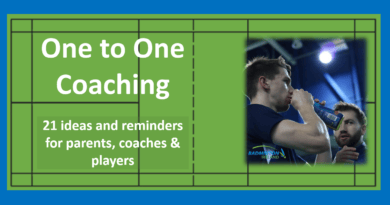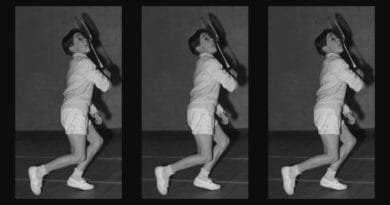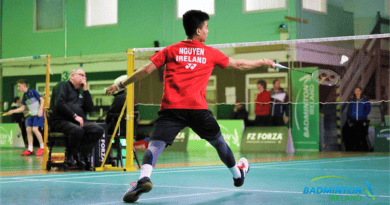The Deep Forehand – a Coaches guide
How and when do you introduce this stroke to your players
What steps could you follow, what are the key components and practices
Come with me and explore the advice I’ve been given, plus the tips and tricks to establishing a great deep forehand
I hope you will agree with me that it’s one of the most important early strokes to learn
Have you read The Deep Forehand – why it’s so important
I recommend if you haven’t, then click here as it will give you plenty of background information
Have you read the 6 Ways to develop an awesome Deep Forehand
This post is aimed at players and will give you some ideas on how to make this an awesome stroke in defensive & attack. It will also help you contribute towards creating a great practice.
To reduce any confusion this shot is called different things all over the World so you may know it by another name, here are a few I’ve heard
• Forehand Pull • Forehand Drag • Deep Forehand
This post is aimed at Coaches and will be full of background information, reasons, why, what, when and how
This is a long read and I recommend that you do it in chunks or come back and later and review the parts you like or find most interesting.
Please stick with it and send me some questions
– – – – – – – – – – – – – – – – – –
Warning
- I hope that you are interested not only in the key technical aspects but when to introduce each one and how to move quickly towards tactical ideas. Please don’t be stuck and obsessed with Technical aspects
- I think it’s vital that you consider the importance of how to place these technical aspects within the learning environment and to make the environment full of game-like challenges and responses
- Would you consider almost deliberately working to ensure that the players ‘forget’ that they ever heard some of the technical advice you give them?
- Do you agree that the true test is in a game or a practice that has game-like conditions not just in perfecting the technical elements?
– – – – – – – – – – – – – – – – – –
1 The key elements: visual and simple
2 Starting at the end of Wallwork
3 Practice Progressions and Progressive learning
4 Feeding
5 Technical & Tactical advice: plus turning Technical practice into Tactical Practice
6 Coaching tips, the important stuff and HABCARE Challenge
– – – – – – – – – – – – – – – –
1. The key elements: visual and simple
I’ve listed some of the great tips and advice that you may want to think about when developing this stroke.
They are not in an order of importance as each could be critical at different times during the development, it’s up to you as the coach to decide when to use each one. It will depend on many factors so all I can do is provide the list and suggest you try them out.
It is also important to say that players don’t need to know the coaching reasons behind why they work. If you use them in early coaching you may deliberately work to ensure that the players ‘forget’ that they ever heard them.
I’ve tried to explain how they help the development of the stroke, help your coaching of the stroke and how they help produce the desired outcome – an awesome deep FH 🙂
However please, please do not tell the players all the reasons why you use the phrases or practices. It’s NOT important that they understand all you are thinking
It is important that all you say and do as a Coach makes a difference to the player, either in their appreciation or in their actions
Become a master at saying less and achieving more
How many of these points do you already use, which ones create the maximum benefit?
“Make a bicep” – this is a simple instruction that creates a great racket preparation position, just look at all the images in this post, can you see ‘make a bicep”‘
“EP” – Early Preparation- throughout my coaching and within this website EP stands out as an excellent concept. Use it here and I guarantee that you’ll see a difference.
“Foot out” – towards the end of the movement inspire all your players to get their foot ‘out’. I know some coaches who like to suggest that it’s a step ‘up-and-out’. I’ll let you decide if you want to use that.
“Hit around the shuttle” – encourage your players to get their foot outside of the shuttle. It’s not required to play this stroke in every situation, but the desire to get there is! Using this concept/idea in early coaching will not only help with the desire to move quickly at the start, but it will also help later when you introduce crosscourt skills. Oh, and it also helps with grip changes.
“Hit-Land” – as you have already encouraged for net skills, this idea/concept works even more effectively in the deep forehand. Encourage a slight pause/wait (if required) so that the hit comes before the land. It is NOT a land-hit stroke as I’ve witnessed being encouraged by some coaches. Ok, it can happen that way, but the ideal is to coach ‘hit-land’ as there are many benefits.
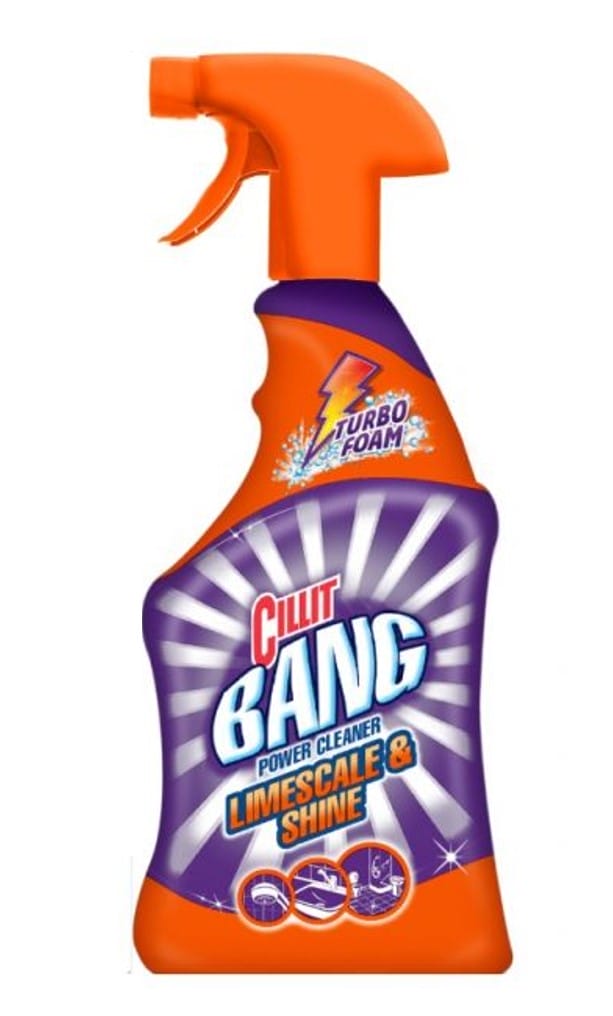 “Cillit Bang” – probably the strangest phrase I’ve heard and used successfully. This is the idea that using all the ideas above the player ‘prepares as for power’ and then waits a small amount of time to unleash a huge amount of power, hence the Cilit-BANG!! Some players like to say it inside their head as an aid (in timing) to help the power to be transferred from the preparation to the hit.
“Cillit Bang” – probably the strangest phrase I’ve heard and used successfully. This is the idea that using all the ideas above the player ‘prepares as for power’ and then waits a small amount of time to unleash a huge amount of power, hence the Cilit-BANG!! Some players like to say it inside their head as an aid (in timing) to help the power to be transferred from the preparation to the hit.
It has similarities to the ‘Crescendo’ part when coaching a Singles High Serve (click here to read that post)
– – – – – – – – – – – – – – – –
2. Starting at the end of Wallwork
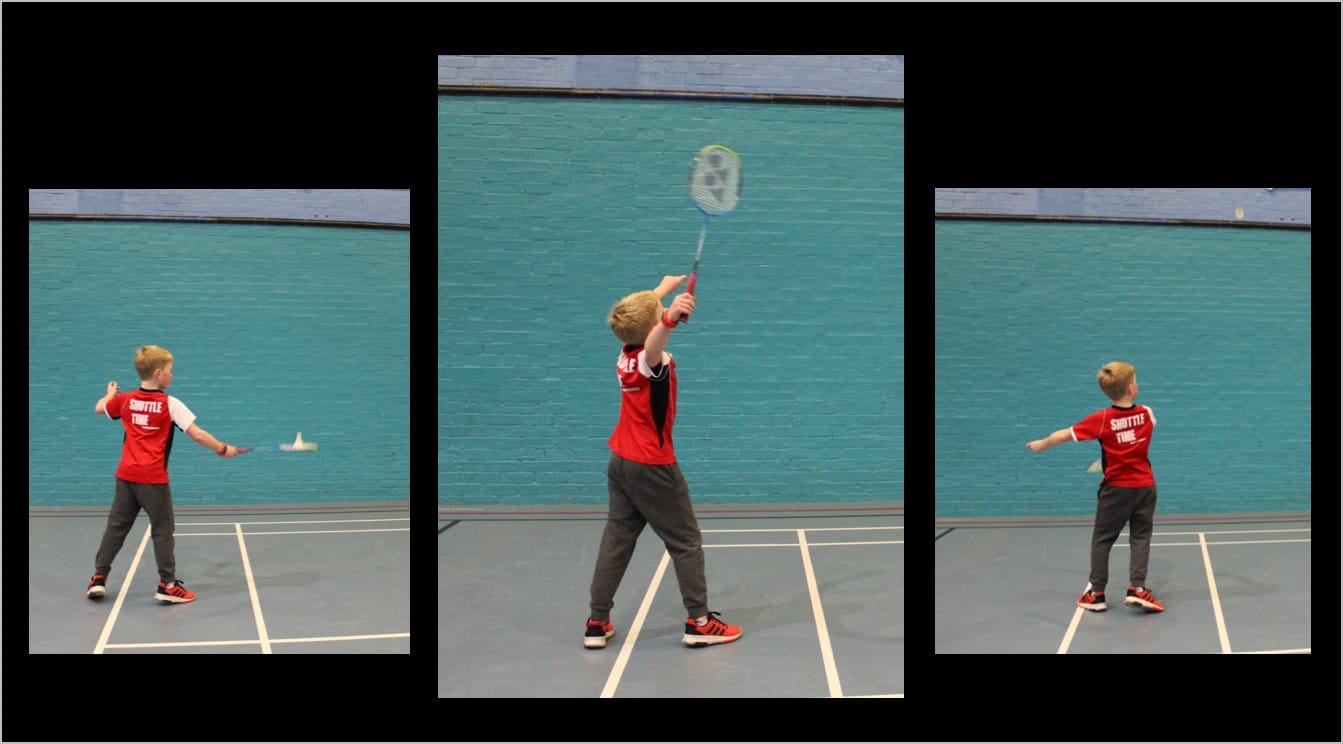 If you have already used Wallwork as a concept to develop below shoulder flicking, players’ stances, racket preparation, task mastery/challenges, confidence + much more, then it is a simple progression to start this stroke in a similar way.
If you have already used Wallwork as a concept to develop below shoulder flicking, players’ stances, racket preparation, task mastery/challenges, confidence + much more, then it is a simple progression to start this stroke in a similar way.
I like to introduce many of the key elements mentioned in part 1 before players go onto the court and try to play the stroke. In fact, I challenge you to do the same.
Some will be without striking but mostly it’s about mini-steps linked to tasks and challenges.
Try using these suggestions
- Self-feeding by starting with the shuttle on the racket in a wide sideways stance. Just like the ‘arms -wide, legs-wide’ of shuttle bouncing
- Pushing up the shuttle into the air out to the side and quickly getting into a sideways ‘make a bicep’ stance
- Watching the shuttle go up and down whilst waiting in the ‘prepare for power’ stance position
- Stepping out onto the racket leg with a ‘hit-land’ or having to chasse sideways if the lift is further away
- Hearing the ‘Bang’ sound of the strike, repeated as it hits the wall 🙂
- The best thing about using Wallwork to prepare for the on-court work is that all the above can be practised at the players’ own development rate. You can progress or regress through the few steps and spend as long as you want trying to master each part.
- Then there is the added bonus that if the player lifts (feeds) the shuttle high but over their head, then they get to try out an overhead throw
– – – – – – – – – – – – – – – –
3. Practice Progressions and Progressive learning
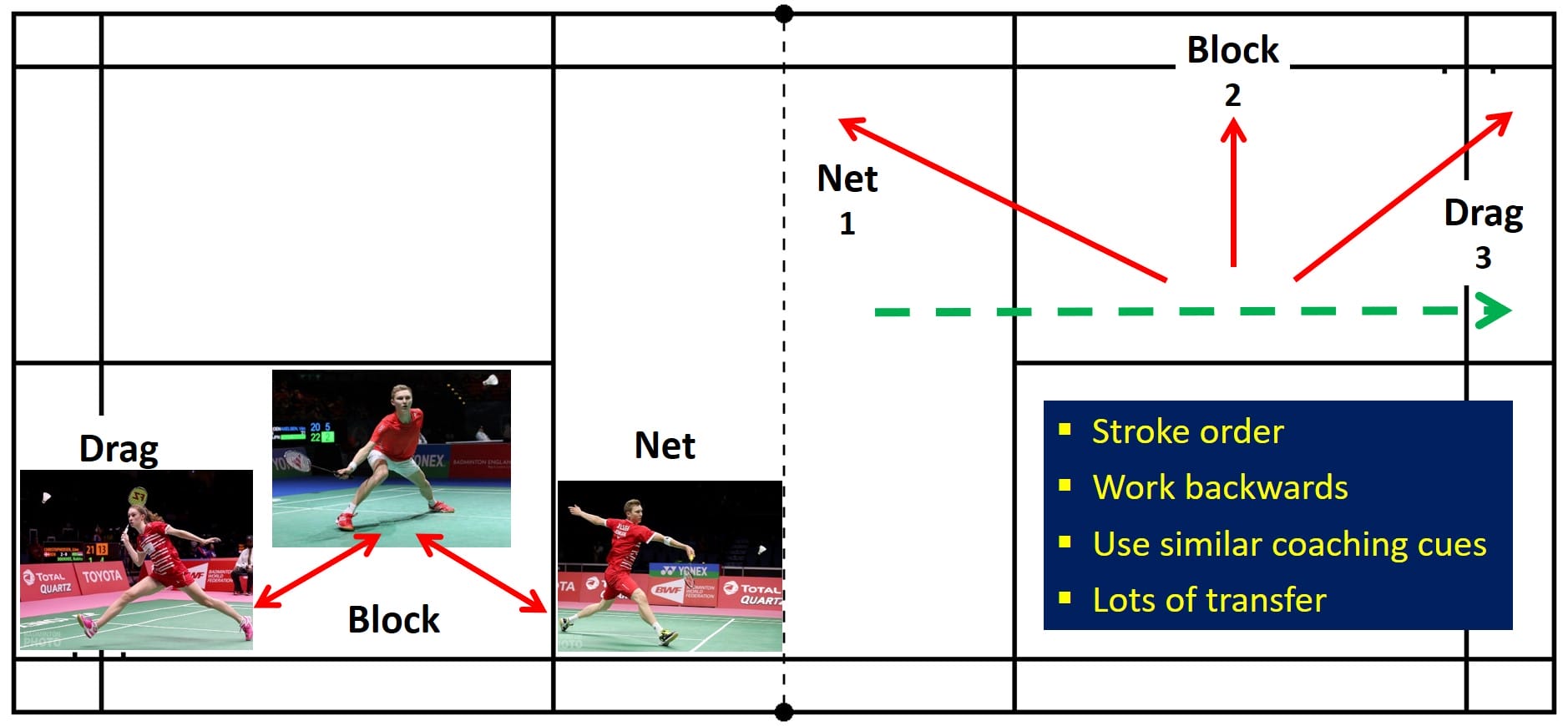
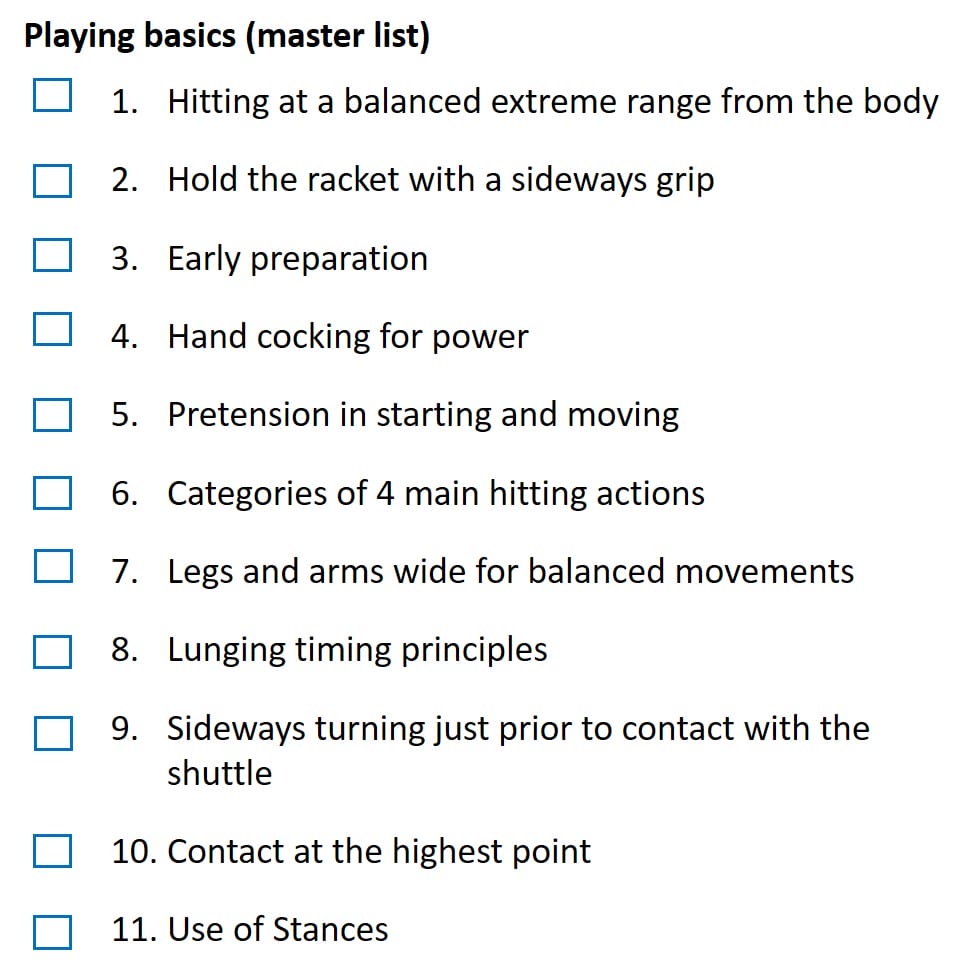 Have you thought about how many of the Playing basics, plus different Teaching Methodologies you could use when working on this stroke?
Have you thought about how many of the Playing basics, plus different Teaching Methodologies you could use when working on this stroke?
That’s why it’s my favourite part of the court to design practices for. There are so many different ways that a practice can be tweaked (altered), plus many opportunities to engage and allow the player to take the lead in the practice.
Best of all it’s easy to introduce game-like concepts well before the stroke is anywhere near perfect, but maybe that’s never the goal! 🙂
Prior Learning & Transfer plus some of the Playing basics
I recommend that before you start in this area of the court you have already spent time working on forecourt strokes & skills, started looking at defensive blocks and of course, combined blocks with forecourt strokes.
Using this approach, you should find that many of the elements that go into making an awesome deep forehand have already been introduced and hopefully part established. Most importantly the style of practice you use will already be known to the player.
How many of the Playing Basics shown here do you think you could already have introduced to the player before you even start in this area? Try ticking off the list. (I would guess at 10/11)
Take a look at the list of Teaching methods and send me an email to contact@badmintonandy.com so we can start talking about which ones you like or want to know more about.
Coaching Methodologies
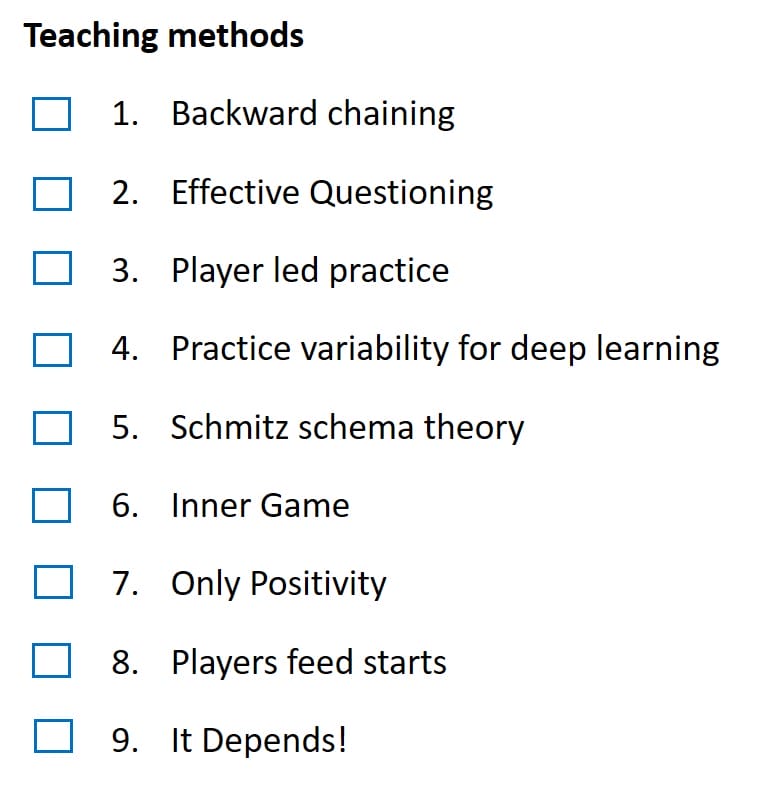 This is probably the most important part of this blog
This is probably the most important part of this blog
The methods you use and selections you make can enhance the practice to great heights
It’s your job to increase player motivation, enjoyment and to provide a learning environment that is full of opportunities to develop. NB, not all attempts will be successful for you or the player.
Which ones you select will DEPEND on what you see and feel while you are coaching.
It will DEPEND on how the player feels at that time.
It DEPENDS on your knowledge (how many do you know and use?)
Every change in the practice, every word you use, every effect on the player you see will give you something to think about.
And, just when you think you have the ‘perfect practice’ the player needs more.
I can’t tell you exactly how to coach or play this stroke it DEPENDS on so much.
How could anyone even advise you what to do unless they were there with you and the player?
– – – – – – – – – – – – – – – –
4. Feeding
Feeding doesn’t just mean standing still and delivering a shuttle
It’s not just the technical way you hold the shuttle(s) or the tricks you use to strike the feeds quickly. It’s much more than that!
It’s important that you assess which feeding style you are going to use and when you will change to another, plus identify the positives and limitations of each.
If someone would like to make a video of each, I’d be happy to share it.
Feeding should replicate (as closely as possible) the game situations. It could also enhance the opportunity for learning (i.e. it may not look like a game) but be serving another temporary purpose.
Both situations could target tactical, emotional, physical, technical aspects or a combination of any or all.
This rule applies to practices when working with beginners and WC players.
The thought’s in a great feeder’s head
- What do I want the player to experience?
- What do I want the player to see before they start their movement?
- Shall I return the shuttle or feed another?
- What will be the benefits of me being on the court or could I get another player to do even more.
The 4 different types of feeding used to help develop this stroke
Coaches, I hope that you will stay with me while I go through each type. If you know of other feeding situations/types please let me know
- Hand Feeding
- Multi feeding
- Single-shot with player input
- Player Start Practices
– – – – – – – – – – – – – – – –
5.1 Technical
When you coach deep forehands how do you ensure that tactical aspects are introduced early and then continued to be developed?
My aim when developing this stroke and possibly all strokes is to enhance the tactical use within a game as soon as there is some part of the skill/stroke established. Certainly, don’t wait until the player can hit 8/10 into a target with near-perfect technique, especially if you’ve been using single shuttle work
What makes a great Technical deep forehand?
- Great EP is essential: there are so many advantages to preparing early
- The ability to hit the shuttle flat to land just behind the service line. Think about frustrating your opponent by giving them something that’s neither a net nor block
- The ability to hit fast but still recover hitting around and getting your foot out will certainly help with both
- The ability to hit crosscourt combined with EP: either fast with or without slice or suddenly ‘holding’ the shuttle so that the stroke appears hard but changes to a soft push
- The mixing up of the starting stances: if the opponent likes to play fast flicks into this area why not change the stance (before they strike) into a backward attacking (receive of serve) type one
Deciding when to start using your intercept jump out
when you feel that players are strong enough and the moment is right for you to work on this new stroke, but still be tactical in your choice
5.2 Tactical Practice
It will be super tough, almost impossible to do this with hand-feeding or single-shot multi
- Get your feeder working as an opponent, that will certainly help
- Use mini-rally (practice) rallies and combine with ‘player start’ feeding as described above in number 4
- Play Conditioned Games where bonus points (+5) are given if the shuttle lands in the rear tramlines or frontcourt. You should find lots of opportunities to retrieve the flat flicks and clears into this area. Don’t forget to protect your forecourt. Oh, and you can use you deep FH heavy slice (straight & crosscourt) to win a bonus yourself, although this is a tough shot to play.
- Play better opponent’s and try to nullify their attack by keeping them away from the net
Please let me know how you design a practice to enhance all the tactical ideas for this stroke
This section is the most important
It may cause you to consider how you currently practice and may also cause you to stop reading
Technical expertise should not be the thought of as ‘skill’
I’d like to suggest that during your practice with players it should be more than just trying to ‘perfect’ all their technical elements.
In fact, the search for any form of technical perfection may be hindering them from becoming skilful players. Yes, they will ‘improve’ in practice but will they become skilful?
What do you consider to be the ‘skill’ part of this stroke?
- Is it the ability to hit lots of shuttle into a target or is the skill more than that?
- How much of ‘skill’ is the Technical part, what else needs to be included to prepare you for a game?
- What makes a player skilful, is it just the ability to hit technically perfect strokes?
- How would you measure the improvement skill, technical aspects can be assessed, but how do you measure your players game-skill?
I believe that the skill part of this stroke is the ability to recognise a situation and play something in relation to that situation
Do you agree with me?
If you do, how can you help players become better at the whole skill, not just the technical part?
Do you think hitting lots of shuttles over and over again is going to give them the skill they need?
How can you help them to improve their ability to read a situation and make a decision? The type of quick almost instinctive thoughts that players make in a match.
Some people call it anticipation, experience, all I know is that you CAN and MUST try to help your players develop it!
Nearly all practices should (as soon as possible) include elements that go beyond just technical practice
Top tips to help you move players from Technical to Tactical
- Let the players start the practices themselves. They will need the shuttle to start. Ask them to use block or racket foot forwards feeds
- Accept that they will intentionally try to influence the practice rallies and allow them to do that. The result may be a messy seemingly unorganised rally (but that a game!)
- Accept that sometimes they will feel uncomfortable and may not make the right decision. You need to ensure that the shuttle is returned.
- Have a goal which is more than just ‘how many came over’ or ‘technically based’. Looking good is no longer the aim, winning the rally is! (or not losing it)
- Incorporate decisions and importantly, keep playing to see the outcome of their decision. Reward and punish by your next stroke (kill opportunities or more struggles)
- Ask feeders to try and beat the player. Include lots of ‘desirable difficulties’
– – – – – – – – – – – – – – – –
6. Coaching tips, the important stuff and HABCARE Challenge
- The best advice or tip I could give you would be to try and develop this stroke after you have established some key playing basics. Start working in the forecourt, progress and link with the midcourt (defensive). Then start and combine all 3 areas.
- Multi feeding in single shots is great to improve the player’s confidence or to reinforce a single technical point. Be aware that there is limited if any real tactical learning.
- Player start practices are the most powerful. Combine them with Blocks & Jump Turns as a split movement
- Emphasising ‘E.P.’ and ‘Hit-Land’ seem to somehow allow players to develop
- Do not get stuck into one coaching methodology, remember it DEPENDS. Be prepared to try all the concepts in no. 3 above.
- I particularly like creating desirable difficulties that the player agrees to or sets themselves
- When I started to use Backward Chaining it changed my practice plans completely. Click in the link to read more 🙂 )
 If you are Technique Geek
If you are Technique Geek
Open a new page in your notebook and down the side of the page write the letters H. A. B. C. A. R. E.
Then try to write all you know against each of the sections
This will certainly test your Technical knowledge about this stroke
Thanks for reading this far, I appreciate your time and motivation
Please send me your thoughts and comments to contact@badmintonandy.com

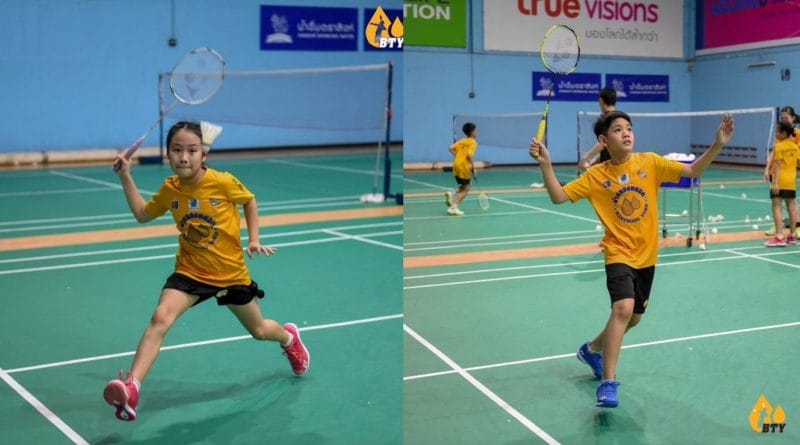
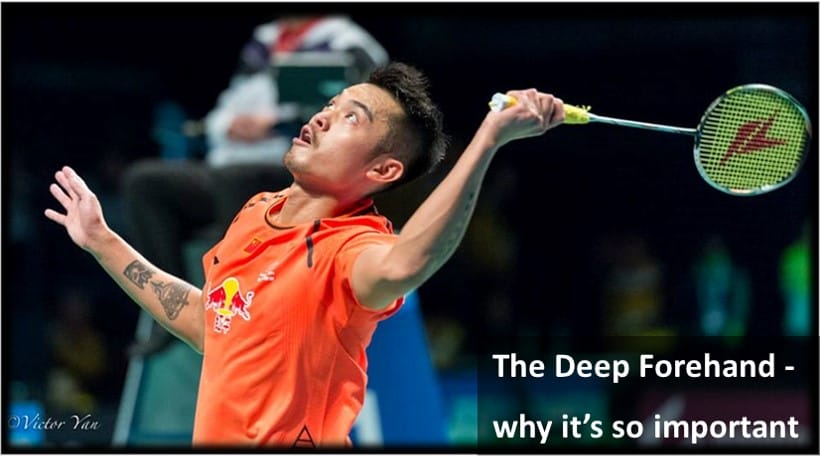

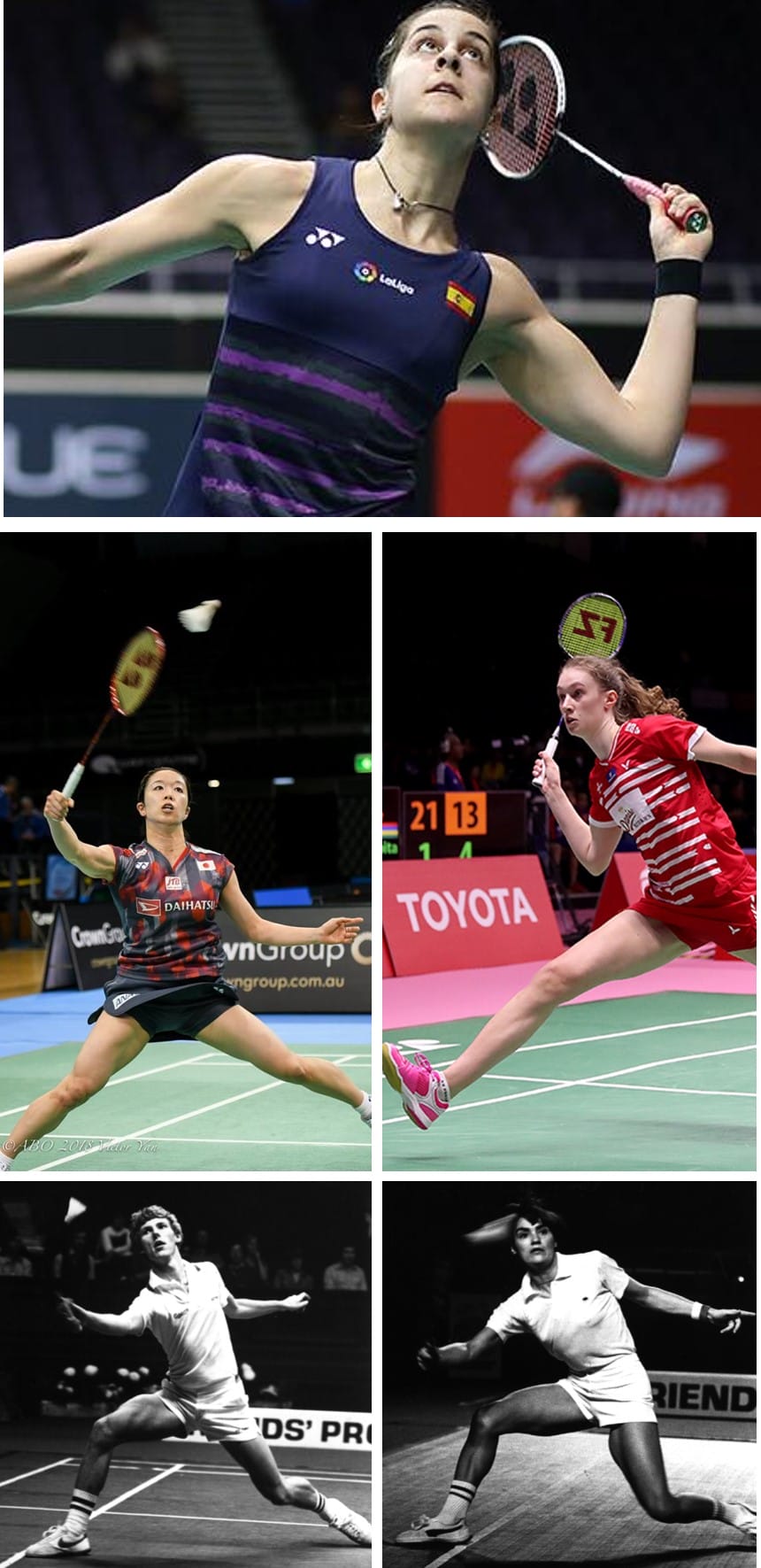
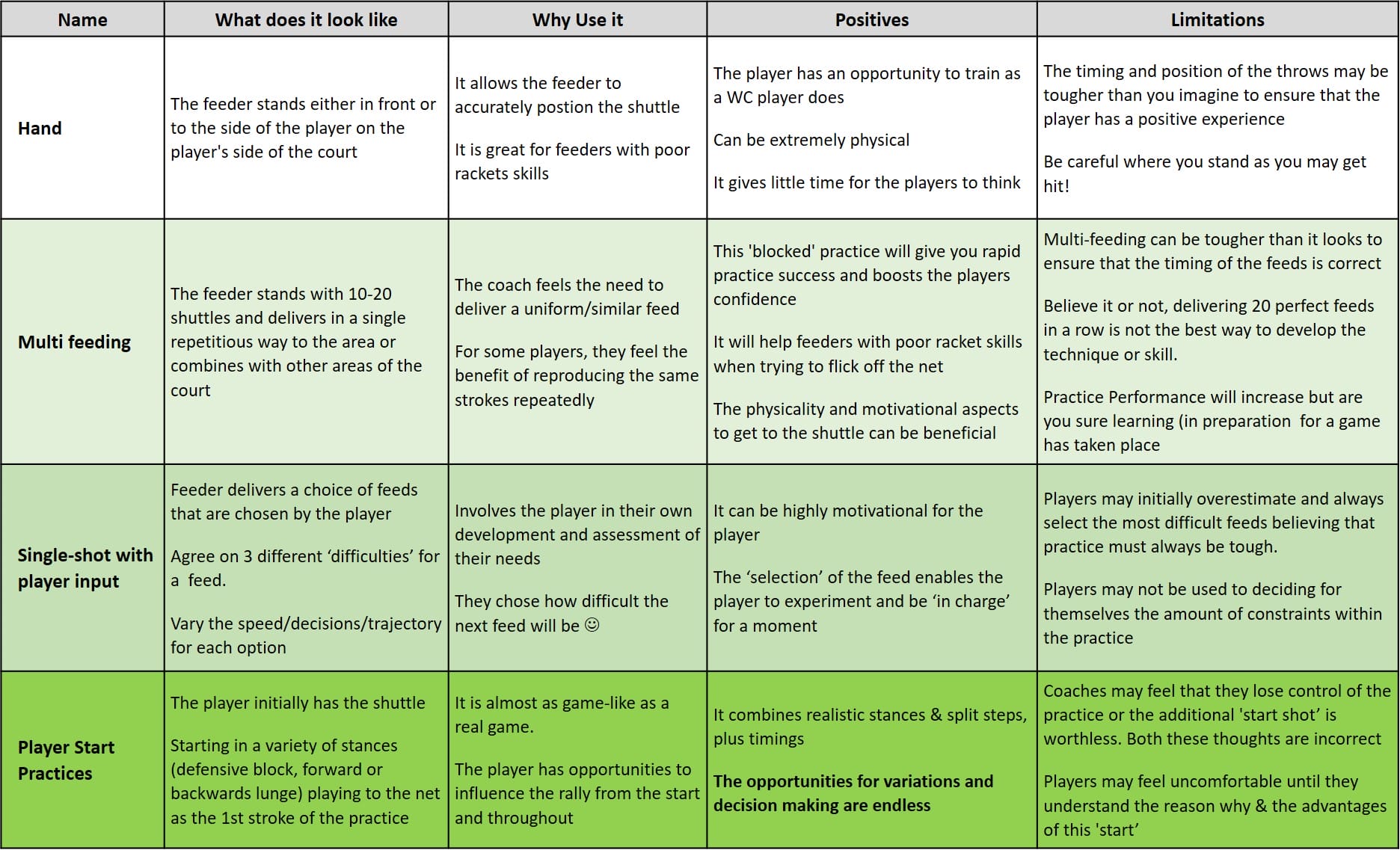

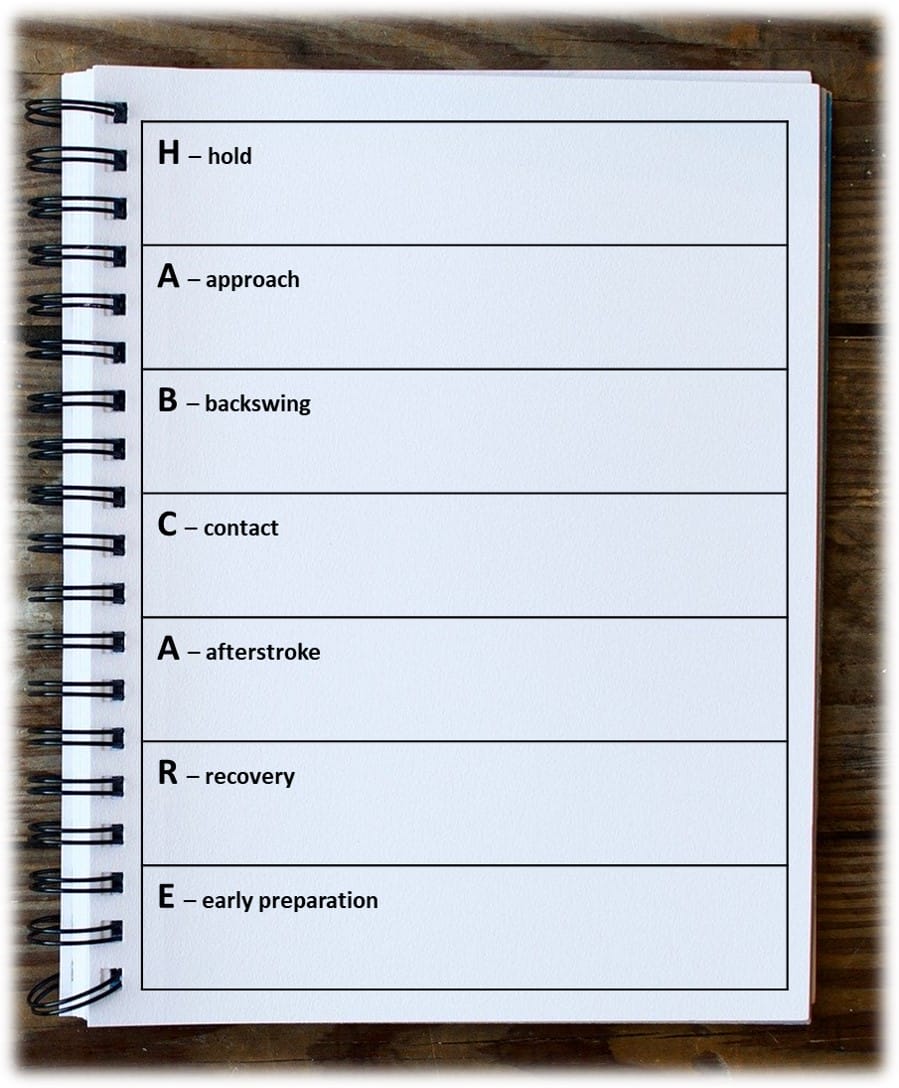 If you are Technique Geek
If you are Technique Geek